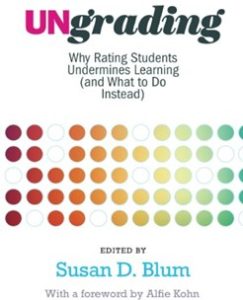Discussion 1 – UNgrading Overview with Dr. Susan D. Blum
UNgrading – Why Rating Students Undermines Learning (and What to Do Instead)
2025 Spring Scholarship of Teaching & Learning Book Discussion Series

In UNgrading, fifteen educators write about their diverse experiences going gradeless. Some contributors are new to the practice, and some have been engaging in it for decades. Some are in humanities and social sciences, some in STEM fields. Some are in higher education, but some are the K–12 pioneers who led the way.
Based on rigorous and replicated research, this book shows why and how faculty who wish to focus on learning, rather than sorting or judging, might proceed. It includes honest reflection on what makes ungrading challenging, and testimonials about what makes it transformative.
Discussion 1 – UNgrading Overview with Dr. Susan D. Blum (January 24, 2025)
Experiences that may indicate the need to rethink “business as usual” (participants shared)
- We are experiencing unusual times
- Students often seem disengaged, passive, and distracted in class
- Students are cutting corners using AI
- Students are struggling with their mental health
- Students view faculty as adversaries
The pandemic gave us an opportunity to pause and think deeply about grading
- Conventional teaching (including grading) resembles a “factory model”
- Sitting in uniform rows
- Teaching/learning measured like time/motion studies
- Students are ranked and sorted
- Metrics are used uniformly to measure time in seats
Grades are inconsistent and offer little useful information to students or others (e.g., employers, institutions)
- Though we may hate grades/grading – it feels like we are stuck with it as a means to assess learning
- Grades tend to reinforce inequities – those who struggle fall further and further behind
- Sorting and ranking leads to harmful effects like cheating, anxiety, toxic perfectionism, shame, “gaming” the system/doing as little as possible
Humans are great learners and the drive to learn is strong – that’s our superpower
- It sometimes seems that we have designed social institutions (schools) that teach learners to fail
- Mistakes should be viewed as information
- Instead, mistakes are penalized
All learning is self-directed – a teacher can create the environment, but students are motivated to actually learn
- Students state, “I love learning, but I hate school”
- There is a tension/mismatch between natural learning vs. what is expected in school
- Curiosity and wonder (intrinsic) vs. obligation and grades (extrinsic)
GOALS and MOTIVATIONS
- How to get an A – do I have to know this for the test VS. do we get to learn this
- We cannot MAKE students do something – creates opposition/tension between students/teachers
- When extrinsic motivation (grades/credentials, etc.) is dominant, it tends to eat away intrinsic motivation
- With intrinsic motivation, learning is the goal – students are curious, want to learn, and use what they learn, – not for the test, but to build skills and know information
- Students should be involved with and take ownership for their learning goals (aligned with outcomes)
RELATIONSHIPS and STRUCTURES
- Relationships change when goals are less top down (teacher) involving less uniformity
- Self-directed education involves diverse ways of learning with diverse assignments acknowledging multiple types of learners and honoring learning from one other as an asset
- Banking Model (stuffing information into brains rather than asking what students are wondering)
- Honor curiosity before providing the answer – active learning approaches are a major part of ungrading
- The STEM course format (lecture, test, grade) may not be optimal
ACTIVITIES and ENGAGEMENT
- Un-essays are more engaging ways of learning through doing, demonstrating what students have learned
- More authentic learning – relevant, self-directed, joyful learning that matters
- Honors students that don’t like writing, faculty who don’t like grading, and diminishes impact of generative AI more likely with traditional assignments
- Freedom of format – may be drawing, multi-media formats
- Students can do hard things when learning is viewed as relevant – solving actual problems/completing self-designed projects
FEEDBACK and ASSESSMENT
- Feedback may come from learner themselves, from classmates, from teacher
- Reflection is a metacognition strategy – self-assessment is a critical skill to learning
- From classmates and peers:
- TAG approach (tell me what you liked; ask a question; give a positive suggestion)
- WOW – I wonder “what if”
- Feedback from teacher should be explicit, usable, and lead to improved learning
- UNgrading Umbrella includes many approaches (e.g., contract grading, specifications grading)
Dr. Blum uses collaborative grading
- Doesn’t spend much time talking about grades
- Mid-semester reflection and written narrative
- Justify the grade they suggest for themselves
Student Comments:
- “All we did was learn”
- “I learned for myself, not for my grade”
Challenges
- Mandates to issue grade
- LMS systems puts most of the power into the hands of the instructor – there may be workarounds to get away from the gradebook features
- Illustrates how embedded grading is
References and resources: https://bit.ly/Blum-Ungrading-Sources
